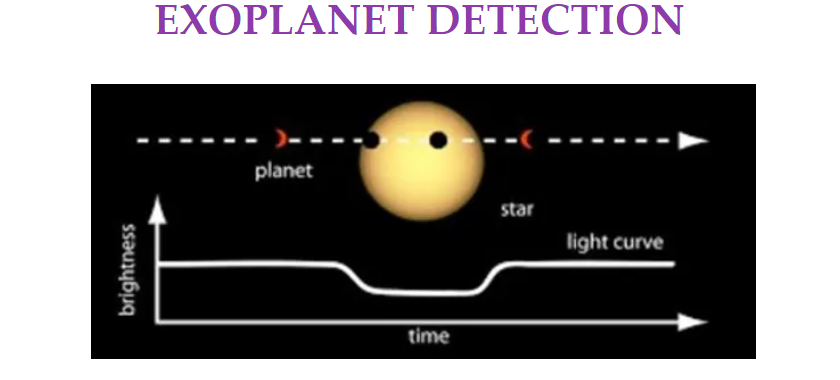Space is euphorically beautiful. It is captivated by glorious beauty of mysterious reasons. Let us explore this infinitely never-ending tale considering a small topic- EXOPLANETS.
The planets outside our solar system are known as exoplanets i.e.; all the planets that revolve around any other star but sun. In the 18th century, the concept of exoplanets emerged, initially met with scepticism due to the prevailing belief that the discovery of planets beyond our solar system was far-fetched and impractical. The first confirmed exoplanet discovery was made in 1992 by Arecibo observatory, where they discovered the planets Poltergeist and Phobetor orbiting a pulsar called PSR B1257+12. Since then, many space missions were launched by various organisations to find more and study more. As of 1 March 2024, a total of 5,640 confirmed exoplanets are listed in the Extrasolar Planets Encyclopedia.
THE TRANSIT METHOD
By definition, a candidate is called a planet if it revolves around a star. Imagine if we placed a satellite that has kept static and observes a particular star. It continuously observes the brightness of the star. When a planet passes in front of the star (from our perspective); i.e.; between the star and satellite, there will be a dip in the star’s brightness for the satellite. The presence of such dips in the brightness vs time graph states an exoplanet. This is known as the transit method. The act of moving of a planet w.r.t its star helps us to understand its presence and dynamics.
Although the mass of the planet is very small compared to its star, the brightness change can be negligible. But this method is highly practiced/ used by many researchers and was proven very effective.
USING MACHINE LEARNING FOR DETECTION
Although the graph states the presence of a candidate, we need more advanced study to confirm if the
candidate is a planet or any other. Machine learning has revolutionized the technology, it pushed the
boundaries to know the unknown by illuminating the pathway with data.
1. The primary requirement of this task is to collect the data from the satellites whose focus is
exoplanet discovery. Kepler, TESS, CoRoT are the most famous missions, all launched by NASA, used by the
researchers. The data from these satellites is open source. The data consists of frequency and time.
2. The data collected is raw and might contain space junk (unwanted noises). To denoise this data, we
can prefer several ML methods. But here we go with the most important and famous one- Fast Fourier
Transform (FFT). FFT transforms data to the frequency domain, where noise frequencies are identified.
Applying filters, like low-pass, preserves signal while attenuating noise. Inverse FFT converts the
filtered data back to the time domain, enhancing clarity.
3. The balancing of data is very crucial for training any model. Once the denoise data is available,
divide it into 80% training set and 20% test set. When we train a model, it most likely learns from
majority set and casually avoiding the minority set. The proper use of metrics, not only accuracy, but
precision, specificity, recall/sensitivity are important. The two methods used to overcome this process
are under sampling or oversampling and SMOTE method.
4. We can plot graphs of our balanced and denoised data to observe the dips in the brightness and by
dodging all the false-positive cases, we can conclude that a new planet is found.
5. Further more information like the time-period and mass of the planet can also be determined using
some physics concepts and our graphical data.
NEURAL NETWORKS
Neural networks serve as the backbone of modern machine learning, mimicking the complex structure and functionality of the human brain to process and interpret data. Neural networks learn through a process called training. During training, the network is fed data and the weights are adjusted based on the difference between the network's output and the desired output. Imagine a neural network as a complex web, like a spider's web with lots of connections. The things it sees (photos) or hears (speeches) are like flies caught in the web. Just like we learn from experience, the network gets better at recognizing patterns the more it sees or hears stuff. Think of the connections as pathways. The more a certain pathway is used, the stronger it gets, kind of like a dirt path that becomes wider and easier to walk on the more people use it. In a neural network, these stronger connections mean the network is learning to recognize specific patterns. By adjusting the strength of these connections, the network becomes a powerful pattern-recognizing machine.
CONVOLUTIONAL NEURAL NETWORKS
Convolutional Neural Networks (CNNs), are like super-analysing detectives equipped with superhuman
tools. Imagine sifting through years of starlight data, endlessly searching for the faintest wobble or
flicker that might hint at a hidden world. CNNs excel at this meticulous task. They act like tireless
assistants, meticulously scanning massive datasets for these tiny clues. By zooming in on intricate
patterns of brightness changes, they can detect the subtle dips that could be caused by a planet
blocking the light of its distant star. This ability to unearth subtle patterns from a sea of data is
what makes CNNs invaluable tools in the hunt for exoplanets.
Cosmology and machine learning, is the ultimate space duo! The mysterious universe must better watch out
as we solve the uncanny faster than a shooting star on rocket fuel.
This article was contributed by Sri Sankeerthana Jadi, a Computer Science and Engineering UG Student (Batch 2022-2026), G. Narayanamma Institute of Technology and Science.

